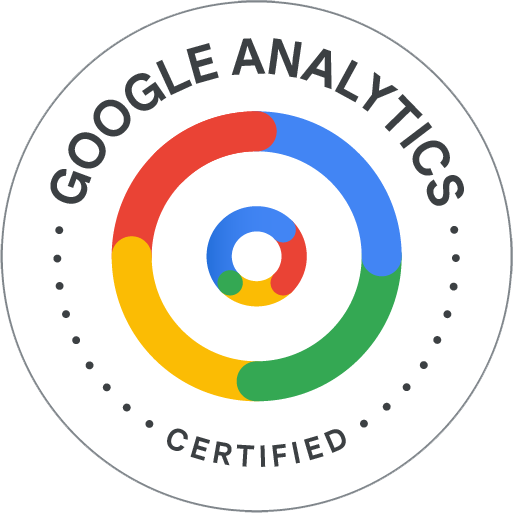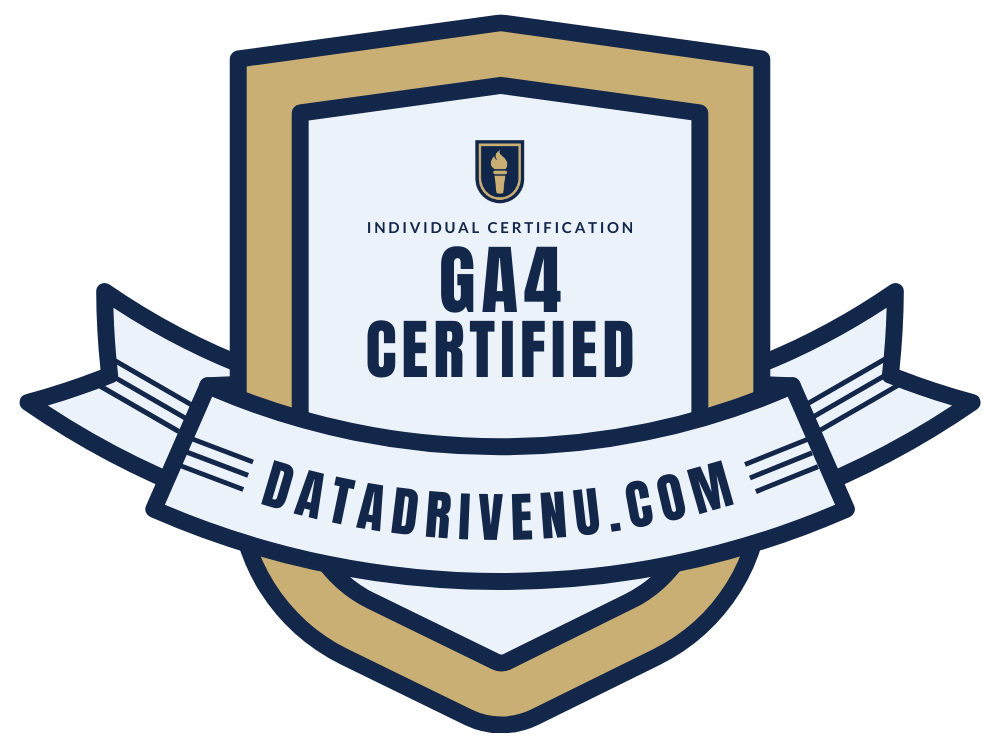Make Confident Marketing Decisions without Being a Marketing Expert
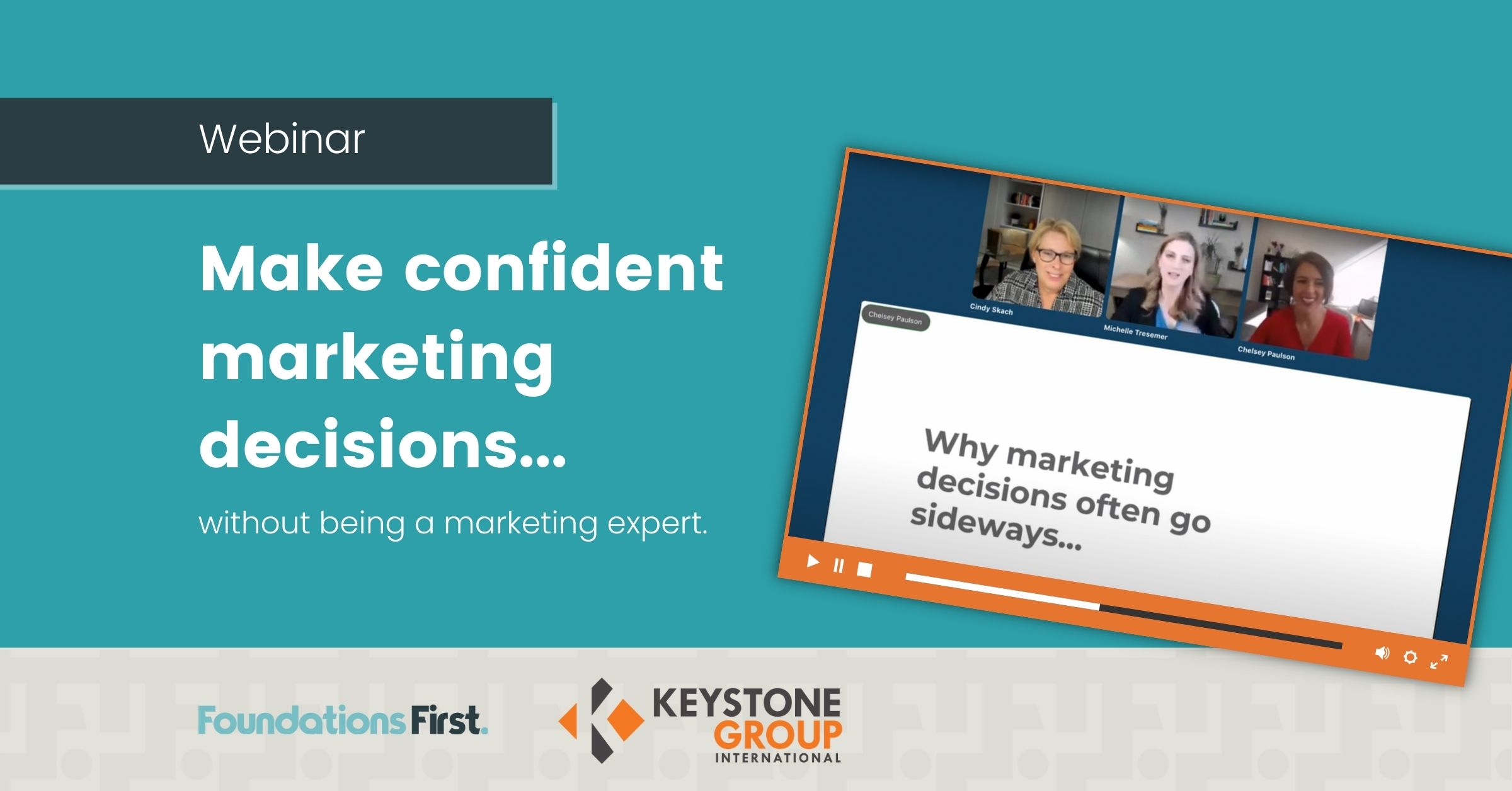
As a leader, inevitably you’ll be asked to weigh in or make a decision involving marketing. If you’re lucky, you understand what the marketing team is talking about. Most of the time, however, it might sound completely made up. You might not be wrong – it might partially be made up BS. (As a rule of thumb if anyone uses the word “synergies” it’s an automatic red flag.)
The cold truth about marketing is it’s freaking fun. There are so many tools, tactics, and ideas floating around sometimes marketing teams have trouble focusing on the big picture. We get in the weeds because it’s fun and often easier to measure than big picture strategic goals that take a long time to see movement…especially in b2bs.
What do you do when marketing presents you with an idea and they are full of energy and excitement?
Do you:
- Take the time to understand the marketing project in-depth?
- Avoid the meetings and questions in hopes the marketing team will lose interest and stop asking?
- Approve the project and feign excitement as long as it’s not an outrageous budget?
- Go on vacation?
These are all viable options, but there is a better way to make sure your marketing team stays on track. Learn these two simple questions and you’ll make thoughtful, focused marketing decisions without having to hear about the details. You can stay high level and your team will stay focused.
Let’s talk about what kinds of marketing decisions I’m talking about.
If you’re more visual, watch our webinar with Keystone Group International below or keep reading…you can choose your own adventure.
Why marketing goes sideways, and maybe why you don’t like it.
Decisions can end up costing you a lot of time and money for not a lot of return. We’ve seen some horror stories run the gamut from…
hiring the CEOs niece as the new social media manager with an unearned hefty salary that made it a toxic workplace and the A-players then quit…
to
dropping $40k on customer research that wasn’t necessary and made no impact.
Let’s look at some common marketing questions…
- Should I hire, outsource, or go with an agency?
- Should we re-do the website?
- Do we need a rebrand?
- Should I hire my niece as a social media intern this summer?
- Should we go to that upcoming trade show?
- Should we run ads?
- Should we launch a new product or service offering?
- Should I start a blog?
I’d bet money you’ve asked at least a couple of these over the years or your marketing team has brought them up in meetings. These are all real questions we’ve been asked more than once – even about hiring the niece as an intern.
Often you won’t even see these posed as questions. They will be presented as “I think we need to start a blog” or “I think we need a new website.” Any statement starting with “I think” should be a red flag.
Pick one of these and think about how you would approach the decision. How do you know if your website is costing you sales? It gets complicated. Often the decision isn’t black or white.
We have trouble making marketing decisions easily and effectively because the question starts from the tactic. We start from the “doing” task. It’s easy because these items are fun and sexy, and we all get to talk about the latest buzzwords and pat ourselves on the back for being hip and trendy. I hate to burst your bubble but it’s bullshit and you’re going to end up with a bloated and overworked marketing department.
It’s easy to start marketing programs but hard to stop doing them.
Look at the diagram below. Most businesses look at marketing starting with the tactics. You can see all the fun execution tasks are on the outside ring.
You think, “oh, we need to write blog posts” or “we should be on social media” or “some agency is going to give us a free SEO audit – we should do that ‘cause it’s free.” On the more expensive side of things you might get bored with your website and think, “we really need a new website.”
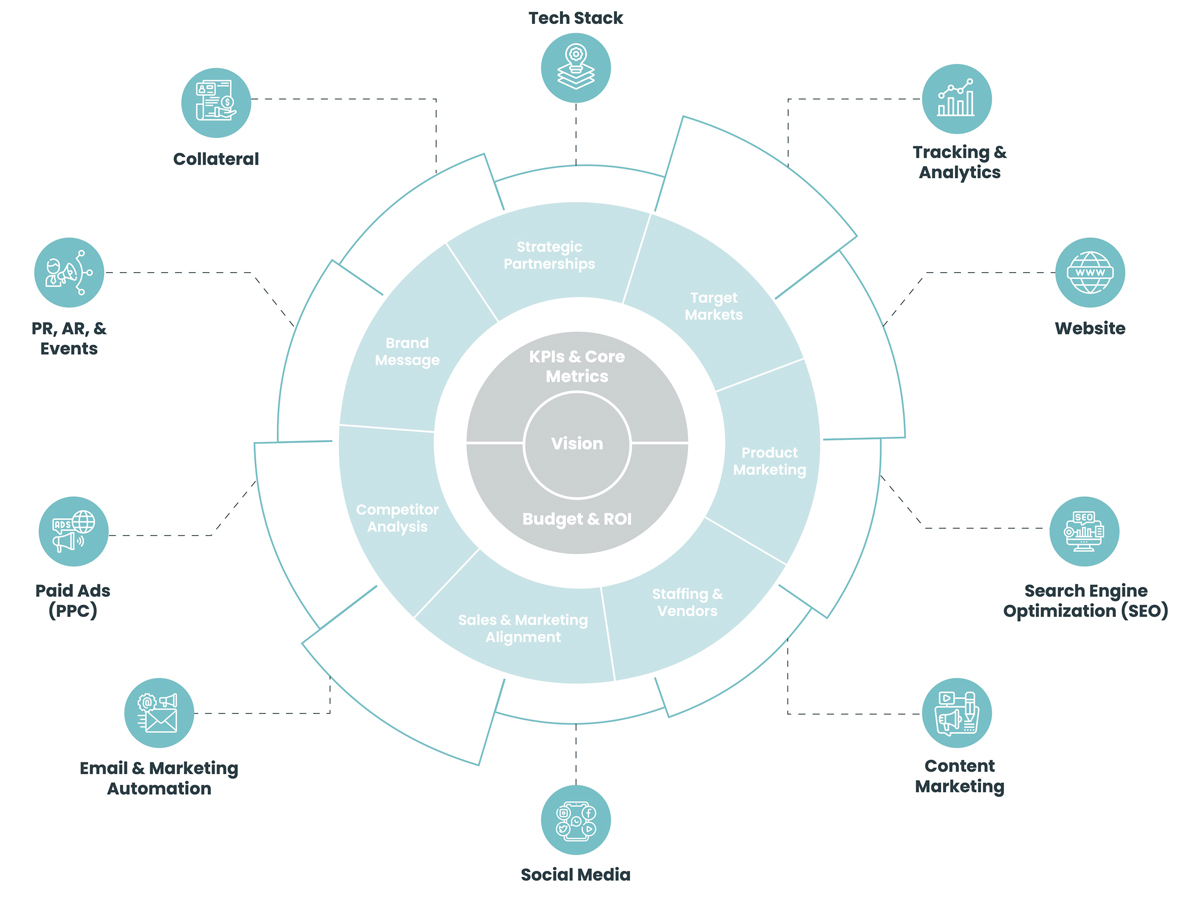
The problem with this approach is you have no way to decide if you should or shouldn’t do those things. These are the tactics. They all sound fun. They all presumably will attract more customers. But…
- Are they the best use of your resources?
- Should you do them at all?
- How do you prioritize all of those fun ideas?
- How do you decide what to spend your time and money on and what to not do?
Here’s the big shift that will save you tens of thousands of dollars…
Make marketing decisions to support your vision. Period.
Instead of only looking at the tactics (the outer ring we saw above), start with where you’re trying to take the company. This is your vision. I’m not talking a mission statement. I’m talking nitty gritty brass tacks vision.
Think 5-10 years down the road. What do you really want?
- Do you want to serve 100,000 customers?
- Do you want to get acquired by Microsoft?
- Do you want to expand to all 50 states or go international?
Notice I’m talking specifics in these examples. It’s not “I want to make the world a better place,” it’s more “I want to end child homelessness in my city.” One is measurable, the other is not.
Your vision is the heart of what you’re trying to accomplish in no uncertain terms.
From that vision you figure out how to measure towards it. Those are your KPIs (key performance indicators). And you use a budget to set your guardrails around what is realistic and possible. It also keeps you prioritizing your efforts and prevents distractions.
These three pieces all reside with the leadership team meaning the CEO, founder, COO etc. As a leader you need to be hellbent on your vision and unapologetic about getting there. If you stay focused, your team will stay focused. It sounds simple but it’s far from easy.
Now that you understand your role as a leader, how does this translate to management and ultimately to answering those marketing questions quickly and with confidence?
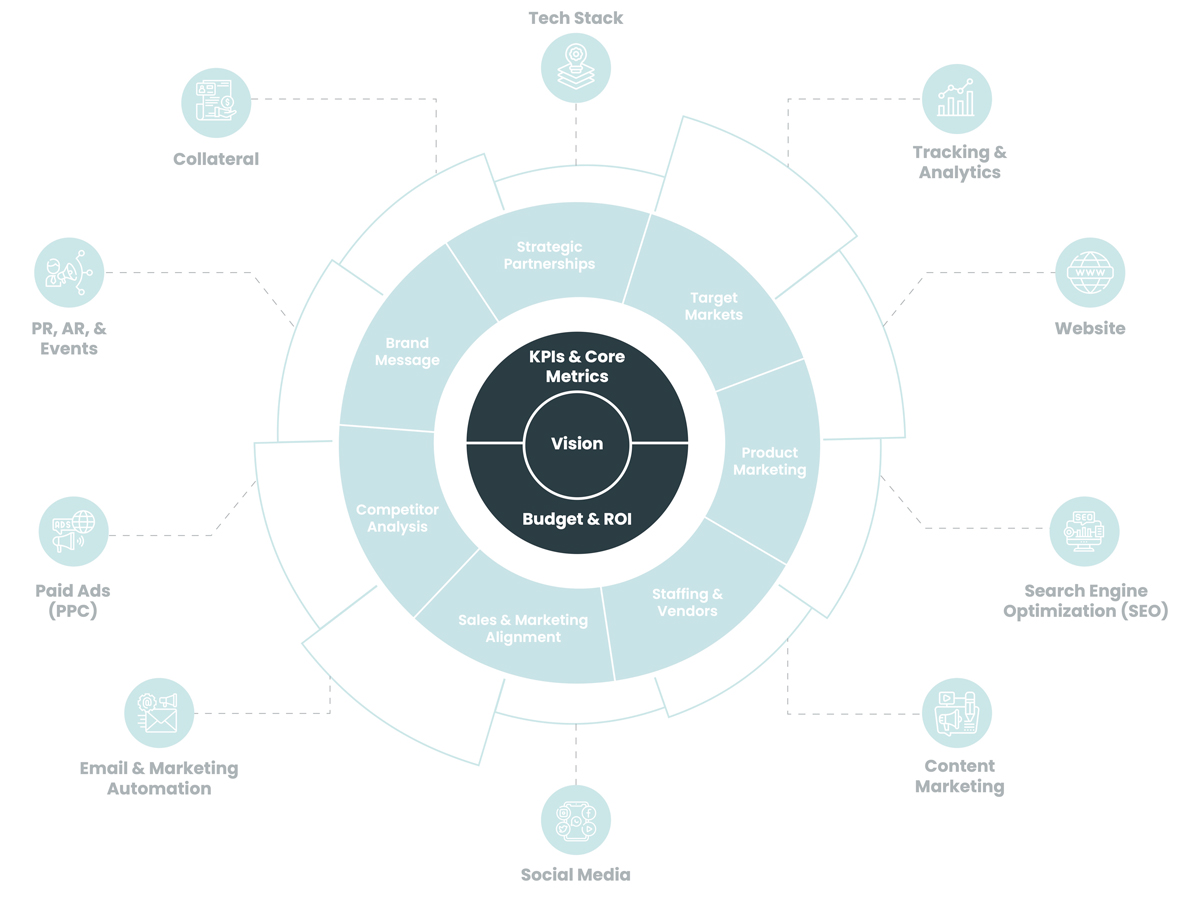
Marketing management makes sure everything is on track.
Absolutely everything in what we call the management function of marketing is geared towards your vision. At this level we ask:
- What target markets are going to get excited about this vision and help us get there?
- What products and services should we offer to get us to that vision?
- What are we offering that is NOT going to get us to our vision? What are we already doing that is a distraction?
You can see how this works. When leadership sets the direction and management aligns the disparate pieces, only then are you truly ready for the execution tactics.
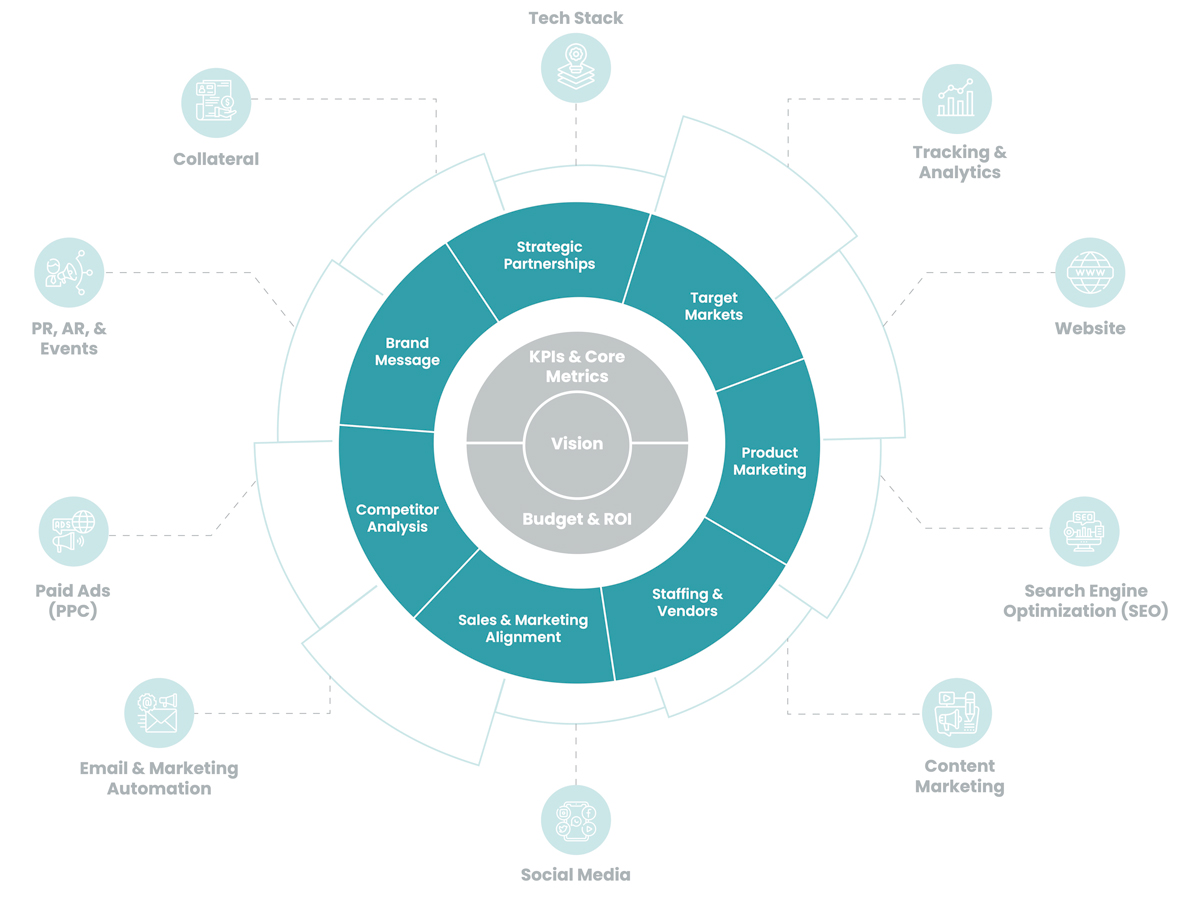
Know when to execute on marketing tactics and when to walk away.
Remember at the beginning, we didn’t have a reason to say no to running ads or writing blog posts or spending hours a day on social media or even hiring the CEOs niece.
We had no way of holding anyone accountable to what they were doing either. If you don’t know where you’re trying to take the company, why not get on TikTok?
With the vision at the center, we now have a way to make those decisions.
Here’s how it works (and I’ll warn you it’s simple, but not easy):
- The initiative in question must align with your vision – it has to help you get there.
- Is there somewhere better you could spend your time and money? In other words, what’s your opportunity cost?
Let’s test this out looking again at some of the common marketing questions we get:
Example 1: starting a blog.
Think about writing blog posts. Is writing a blog post a week going to help you get to your vision? If it is, then ask “Is it the best way to use my time and money to get to my vision?”
Maybe your website is a disaster and desperately needs a refresh. Maybe your audience doesn’t read much of your written content and a podcast would resonate better. Maybe face-to-face time with your prospects and customers is a better use of resources.
See how it forces you to look beyond just the blog posts?
Now you can’t get to this point if you don’t know what your vision is. 98% of the time the decision is going to be a heck yes, or heck no…if it’s anything other than an enthusiastic YES, then probably don’t do it.
Example 2: let’s go to a conference.
Here’s another example: We often hear clients talk about going to a conference for two reasons. 1. They have always gone and 2. Their competitors are there. That’s not good enough.
The event must:
- get you closer to your vision
and - be the best use of your resources.
Maybe sponsoring a booth at a conference is aligned with your vision, but would that money be better spent on an analyst report (Forrester or Gartner) you can use all year?
Example 3: hiring more marketing staff.
Should you hire marketing staff? Is it going to get you closer to your vision? If yes, look at the cost of the position and onboarding time. Is there somewhere else you could spend that money to get you to your vision better?
See how this works?
Example 4: the website needs an overhaul.
What about a new website? Will it get you closer to your vision? I could almost always justify it will. But…
Is there somewhere else you could spend 10, 20, $50,000 that would be better?
- Maybe you could get new equipment or ERP software that will 10x your production.
- Maybe your support team is overloaded, and support tickets are backlogged for months.
I’d rather put money towards adding a support position.

Start making confident marketing decisions.
You can see how you staying focused keeps everyone else focused too. All you have to do is ask the two questions whenever someone pitches you something:
- How is this going to get us closer to our vision of ABC?
- Is there somewhere else we could spend that same time and money that will get us there faster?
Yes, make the staff answer those questions. In fact, they should be answered at the beginning of any initiative proposal that hits your desk. If the questions can’t be answered then don’t even look at the proposal.
Let us know how much money these two simple questions save you!
Webinar Transcript
[00:00:00] Chelsey: Before we dive into our main content, this is our cornerstone that we are working around within these workshops, which is our Impact Model. We believe all of these building blocks is what impacts your culture and impacts your business. And so in everything we’re talking about, it’s what does the business need, but then what do the humans in your business need and how do we bridge that gap? How do we find that intersection between the business needs and the human needs?
The building block we’re talking about today is brand. When we say brand, we’re talking about both internal and external brand, so employment brand but also what is our marketing brand? How are we coming across in the community, in society, with our clients and customers? What we feel is that culture is what’s really building up that brand.
When we came across Foundations First Marketing, who’s gonna be presenting today their values and their thought process on marketing and brand aligned so closely with ours that we knew we had to have them come on and share their thoughts and their background on marketing. Today we’re gonna spend a lot of time talking about making confident marketing decisions, even though you’re not a marketing expert.
I’m assuming the vast majority of you on this call are not marketing experts. If you are, awesome, share your thoughts and insights with the people at your table. But the intent is that a lot of us don’t have a deep understanding of what is marketing, what works, how do we manage if we’re outsourcing our marketing, how do we manage that? How do we know if they’re doing a good job? What are the questions we should be asking? Those are some of the things we’re gonna be digging in to today.
I’m gonna call our panelists onto stage. And I’m just gonna ask you to do just a quick introduction of what Foundations First Marketing is, and then each of your roles at the organization. Cindy, can you start us off?
[00:01:44] Cindy: Yeah, well, thanks for inviting us. We’re very excited to be here. It’s gonna be a lot of fun today and very interactive. We believe the strategy is very important before you go into tactics. And we wanna guide our clients to do that. I’m the fractional CMO. And that’s how I got our clients from a strategic standpoint and I work with the C-suite.
[00:02:02] Michelle: I am the other side of that. So Cindy’s fractional CMO way up here in hierarchy. I’m kind of the weird person who looks at strategy and figures out how to execute on that strategy. So I call myself an execution strategist, so what to do, how to get to that higher level.
[00:02:19] Chelsey: I love that. Since this is geared towards non-marketing experts help us understand, sometimes marketing can seem very mysterious, right? What is it? What does it all include? What works, what doesn’t work? Can you help us demystify what marketing is?
[00:02:35] Michelle: At the root of what marketing actually is. Okay, this is gonna sound crazy simple. You sell something, you sell it to solve some problem that exists. All marketing does is get you in front of the people who have that problem, so you can solve it. That’s it, it’s the most efficient way to get in front of those people. Marketing is just a tool we have.
[00:03:00] Chelsey: Oh, I love it. And we talk a lot about tools and we need to have a lot of different tools in our toolbox to support our businesses and support our people. And this is one that is really helping to support the business. And then of course the people that are in the business too. So awesome. So let’s kick us off here. Why do marketing decisions often go sideways?
[00:03:19] Michelle: When we don’t have a way to make decisions. We have no way to say yes, this is a good idea or a bad idea. The decisions go sideways and we make decisions based on gut feeling or, oh, that sounds fun. Let’s go do that. If anybody’s wired, like a visionary, like I am it’s shiny object syndrome. I get so excited. I will spend a week down a rabbit hole that does not serve my business, but boy, is it fun to do, right?
I’m sure we’ve all been there. But what this does is cost you a ton of time and money, and it can derail an entire team. If there’s any CEOs, leadership people on this meeting today, hopefully there are, if you’re distracted, you’re gonna get your team distracted because they want to please you.
So this is how they go sideways. I would bet money that you’ve asked these questions at least a couple times over the years. These are all real questions, including the one about, should I hire my niece as a social media intern this summer, Cindy and I have gotten that one.
If you don’t have a way to answer them, you could spend six months trying to develop your content calendar for a blog that one day you just woke up and said, we should have a blog. Why don’t we have a blog?
You can see where if you started doing all of these things, they’re just scattered, right? You have no reason.
[00:04:35] Chelsey: I see this happening in our clients when we’re working with them on their strategy and where should we go? We spend all of this time thinking about our strategy of big picture, where we’re going, but then when it gets to rubber hits the road, like, how are we actually gonna make this happen?
It’s like, oh, let’s try this. Let’s try that. It’s like, yeah, it’s a scattered approach. And there’s not the strategy behind all of the marketing side of this and how we’re showing up in front of our clients of really showcasing what it is that we have to offer and how it’s gonna help.
[00:05:06] Cindy: Yeah. And, and I think it’s really important to establish the strategy before you even go down these paths. Otherwise you end up wasting time and money and being very inefficient about what you’re doing there. It’s so important to pull it back up to the top and the focus of the business.
But Michelle’s gonna talk a lot more about that.
[00:05:21] Chelsey: Yeah. Awesome. Let’s dig into that.
[00:05:23] Michelle: We just talked about marketing and what it is and I mentioned tools and Chelsey mentioned tools. This is how Cindy and I approach marketing. It’s really 20 core marketing functions. And this is your toolbox.
These are all the tools we have to use, but this is where decisions go sideways. Most businesses start with that outer ring. They should all look very familiar to people. It’s what technology you’re using, social media, search engine optimization, your website, your paid ads. These are all of the things, the stuff, right?
It’s the fun we call ’em fun execution tasks. But they’re all on that outer ring. So you think, oh, we need to write a blog post. So you look over at content marketing or we should do social media or some agency is gonna give us a free SEO audit. We should do that because it’s free. You don’t stop to think, oh, that’s gonna take my staff all week to get them the info they need.
It’s not free. It’s a distraction. On the more expensive side of things. Maybe you’re bored with your website and you think, oh, we really need a new one. The problem with this approach is you don’t have a way to say, should we do a new website? You just kind of think, oh, I’m bored with it. Is it going to delight your target market? Yeah, it probably will. But is that the best use of your resources?
[00:06:42] Chelsey: Well, then even also thinking yes, maybe you do need to redo the website, but what are you gonna put on the website? Right. Like, are the words and the pictures, does that matter? Does that align? Just making it look flashier does not give you a whole lot.
[00:06:56] Michelle: Yes. So yeah, that’s the exact point you’re gonna spend all this time and money on all of these things, right? How do you prioritize all of this stuff? You know, I could look at anybody’s assets on this call. Absolutely anyone and rattle off 10 things I think you should do to improve your marketing. Should you go back and execute all 10 of these? Probably not. Because you need to prioritize right? What is going to move you forward the fastest. Okay. But we’re gonna talk about what does forward mean? This is gonna save you tens of thousands of dollars. It saves our clients. I’m gonna show you the trick.
Of all these marketing tools, the heart, the core, is your vision. I am not talking a mission statement. This is a nitty gritty brass tacks what you want, it might be, I wanna be on the cover of Forbes. It’s what you really, really want in very tangible terms. It’s not fluffy.
It could be, you want to serve a hundred thousand customers. Maybe you wanna get acquired by Microsoft. Do you want to expand to all 50 states? Do you want to go international in the next five years? Do you see? Cindy loves it when I go tactical , but they’re really specific, right?
This is not, “I want the world to be a better place.” Instead it’s “I want to end child homelessness in my city.” It’s very specific. It’s measurable.
[00:08:19] Cindy: It’s not aspirational. It’s actually something that you can achieve. And measure.
[00:08:23] Michelle: Absolutely. From that vision, then you’re gonna figure out your KPIs, your key performance indicators. We wanna measure towards that vision. Everyone freaks out about key performance indicators, their KPIs, and they end up putting junk in there, like organic traffic to your website.
That is not a key performance indicator. We want to measure progress to that very specific vision. If I wanna serve a hundred thousand customers, the measurement is easy. It’s how many customers have we served? If you wanna get to all 50 states, it’s what states are we in? It’s so clear. You can’t mess it up. Everyone knows what you’re trying to do.
Underneath that is your budget. So if you said, um, you have unlimited money. What are you gonna do? Where are you gonna travel? Your brain fritzes.
You can’t decide because there’s so many decisions you could make in so many places you could go. You can’t do it. You get paralyzed. The budget puts your brain into this really creative mode. It’s how can I do this? What is the best way to use this resource to accomplish this vision? And then everything gets prioritized beautifully, because you’re asking the right question.
[00:09:33] Chelsey: So question on the budget, because I’ve gotten this question a lot from clients. Well how much? What’s the right budget? And so I’ve heard different percentages of revenue and in different things. So is there kind of a loose guideline you can give for how much you should be spending on marketing?
[00:09:49] Michelle: I always hate that question too. There are all of those guidelines. I don’t personally like them. We have clients who are 50 mil revenue who have no one in their marketing department and they spend next to nothing. It completely depends on industry.
[00:10:03] Cindy: That’s why we walk our clients through where they are today, what their purpose, how they’re gonna find their target markets, their ideal customers.
Like Michelle said, it might not mean they need to spend money. So if you just go by a formula that says, okay, X amount of revenue, and then they’re gonna spend a lot of money on lead generation and that’s not really getting them to their goal. It’s more about being strategic and finding out what is it gonna be best to help them find the ideal customers and tell their story. So we don’t like to have a cookie cutter approach. We say it really depends.
[00:10:32] Michelle: If your vision’s in the middle, the next ring out it’s management functions. And hopefully you’re familiar with a lot of these terms too. Everybody talks about target markets. This also includes what products you sell, what products and services you’re offering. But you’re approaching it with the vision at the middle. So it’s not, oh, we should sell all these widgets. It’s what products and services are going to get us closer to that vision. A big exercise Cindy and I like to do with clients is list out all of the products and services you sell now and go through and figure out which ones are going to get you closer. And which ones are not. Maybe 80% of the time there are things that they are trying to sell that are way off base and a distraction. So you can shut those off. Same with target markets, people who are trying to serve everyone. No. You’re gonna serve no one. So which target markets do you want to talk to that are going to get you closer to that vision?
Then when you have the vision and you’ve got all these management pieces in place, you know your target markets, you know what you’re gonna sell, you’ve got your brand message dialed in only then do we get to that outer ring? Now we can talk about this fun, you know, the execution tactics, but here’s the difference.
It’s not, should I go to ABC trade show. Now you’re shifting your thinking. You’re saying, what trade shows should we invest in that are gonna get us closer to our vision? Okay. So you’re focused on the vision, not the doing of the task. And it’s really hard to get stuck in the doing of the task because it’s fun. And you’re bombarded with agency messages and ads and software, all telling you, you gotta do the thing. It’s all about the task. It is not. The task is a tool to get you to the vision.
[00:12:16] Cindy: Well, and I would add if you’re just focusing on doing the task, I mean, you risk spending a lot of money on something that’s not appropriate for you, and then reaching the wrong audiences, saying the wrong thing. I mean, it just goes down this path that’s not fun.
[00:12:27] Michelle: I use TikTok as an example, because it’s huge right now. And B2Bs have asked us, should we be on TikTok? Because they wanna do it, because it’s fun. But if they don’t have a vision, how am I gonna tell them that’s a wrong move?
They have no direction. So there’s no way to say yes or no, but if you have a vision you can quickly ask, huh? Is TikTok gonna get us closer to getting in all 50 states? How is it gonna do that? Yeah. It’s amazing to have that shift right.
[00:12:59] Chelsey: Well, and when you start at the core, right of what is our vision? What are we aiming for here? What are we trying to get to? And then who’s our target market. What are we offering? And then what exactly are you gonna say? And which, you know, tech option that we’re utilizing social or whatever it is so many times, if we don’t start at the core, we are unintentionally targeting the wrong clients and then that’s when we get these clients that are not ideal clients, that aren’t a fit for what we’re offering and it doesn’t work well for us or for them. It’s not fun. It’s not effective, it’s not impactful. And so I think just having start, you start from the core, you start from what really matters and you work this way, I mean, this just makes perfect sense to me. And I think because I am a strategist, right? So I always start with strategy. Where are we going? How are we gonna get there? And then the execution. So that’s why I said we just align so closely on this. I, I just love it.
[00:13:56] Michelle: We’re gonna show you how to do this. It’s crazy simple, but it’s not easy. First you ask, is this going to get us closer to our vision? So for anything, do you need a new website? Do you wanna go to the trade show? Any of those questions? Do we need to offer a new product? Is it gonna get us closer?
Second, and this speaks to opportunity cost, is there somewhere else you can spend your time and money that’s gonna get you there better?
I’m gonna give you a quick little story. I was doing some pro bono consulting for a nonprofit a few years ago. During our kickoff meeting with the entire board, the executive director proudly stands up really tall, and he says, Michelle, I know marketing.
I’m doing awesome. I write a blog post a week. Cause to him, that was, that was it. It was content marketing. He wanted to write his blog post. So proud of it. And it was lovely. It was a great blog, right? And usually leadership is really hard to get content out of. So I was thrilled, but I’m also strategic. So I dug a little deeper and I asked, you know, how long does it take to do that blog post?
He said four hours a week. The executive director, the CEO, spending four hours a week on a blog. Being the data nerd I am, of course, I go to look at what are we getting for that four hours from the executive director, 8 to 10 views. Lifetime of each blog post, and you gotta know some of those are him.
So then here’s the interesting kicker. I talked to the staff about how does he spend his time? And it turns out if this guy has lunch. Okay. If he goes to lunch with a donor, he walks back with $500 to $15,000 in his hand. They cut checks because it’s an awesome organization. So then you do the math.
Should the executive director spend four hours a week writing a blog that maybe him and his mom are reading or should he go to one to two more lunches and build relationships with the people who care about his mission more than anyone else, and they’re gonna put their money there. So this is why the vision comes first.
[00:16:02] Cindy: If you want to do that capital campaign, if you wanna, whatever that big thing is that you want. You have to prioritize; is the time better spent writing content or doing that face to face? Hopefully this makes a little more concrete on how you ask these questions.
[00:16:21] Chelsey: Yeah. And the examples are really helpful and that like hearing that it’s like a no brainer, but if you don’t step back, if the time reflect and think about our initiatives, do they make sense? Are we getting anything from them? I think that’s just a perfect way to start.
[00:16:36] Cindy: And this is something you kind of have to train yourself to do. It doesn’t come naturally. You know, like Michelle talked about, everybody wants to do, everybody wants to go into the tactics, so you have to train your whole company to say, let’s take a step back. Let’s put everything through these two questions once you establish your vision.
[00:16:51] Michelle: We’re talking about vision a whole bunch, and everyone’s probably asking what the heck is a vision. What does this look like? It has to be measurable. It has to be realistic and attainable. If you come up with something ridiculous, no one’s gonna believe you. And the staff are gonna lose interest. Like who cares? Is it inspiring, you know, and this comes back Chelsey to culture, these next two inspiring and cultural, right? You gotta get buy-in from the people that are gonna help you get there.
That bottom one is just a quick example Cindy and I made up, we wanna work with the top 10 U.S. manufacturing companies in the Fortune 500. It does not get more clear than that. And we actually had a client who had a similar one to this. They can put the names of all of those companies on the wall of their offices. That is inspiring. It’s like, yes, we’re gonna get there.
And it’s crystal clear when you ask your questions, is this gonna get us closer to the vision? Absolutely. Every single activity at that company is asking, is it gonna get us that introduction to that person at ABC company? Do you see how clear it makes it? So when you say, should we be on TikTok? It’s like, no, because those 50 companies aren’t there.
[00:17:59] Chelsey: So the very first thing, if people were saying, okay, what do I start with? The very first thing is, do you have a vision that everyone’s aligned with a leadership team is aligned with and the rest of the company knows. And if you do, then move on to the next ring. But first we need to have that vision, that strong, concise vision that has these different components to it.
[00:18:21] Michelle: Absolutely. Now this is the same questions, but through the lens of that new framework, we just learned. You can actually answer these cause it’s easy. Should you run ads? Is it gonna get us closer to our vision? If it is, is there somewhere else we could spend that money and an example, Cindy and I see a lot is they wanna spend all this money on ads, but when we dig in, come to find out they have a huge backlog of support tickets.
They couldn’t even take the new clients if we brought them in. So I would rather invest, you know, instead of spending 50 grand on a brand new website, that’s amazing. Go put that towards a new support person. So you can actually serve the customers better. It gets your brain thinking in different ways when you position it this way, it makes decisions a lot easier.
[00:19:06] Chelsey: Well, and this goes back to the metrics too. And if we have metrics that we’re trying to track to, if we’re not hitting those, we can’t just keep going. We need to stop and say, why aren’t we hitting those metrics, dig into it. You know, if it’s, you know, we wanna go into a trade show and get X amount of potential leads or meetings or whatever. Well, if we’re not doing that, why not? Is it the wrong trade show to be attending? Are we not selling ourselves right? Are we not asking those questions so that we make sure that we don’t just say, oh, it doesn’t work. So we’re done with it. Well, you gotta dig into it a little bit deeper.
[00:19:41] Cindy: Yeah on tracking the right metrics that are tying back to the goals of the business. If you’re tracking a metric like Michelle talks about organic search, that’s not tying back to the goals of the business. So it’s not gonna tell you the answers to the questions you were just talking about, or these two questions that we have.
[00:19:54] Chelsey: The questions that we’re asking is very simplistic. It’s what is your company vision? This is where we need to start. What is your company vision and how does the information that we’ve shared today, change how you might make your marketing decisions going forward? So what’s your vision and how are you gonna maybe change how you make your decisions going forward?
I hope you had great conversations. I know our table was having some really great conversations. We can always learn from one another. I’d like to invite Kristina up onto the stage to share some of her kind of aha moments, lessons learned her key takeaways from our conversation today, just so that she can share with the rest of you.
[00:20:35] Kristina: Thanks for having me up here. I’m excited to share. I definitely got a ton from it. I think the biggest thing is, I didn’t realize that wow, right at the center, at that core, I still have some work to do with the vision. Sometimes being the visionary, again, the shiny object. You’re like, I wanna do this and I wanna do that. I have big aspirations, but it’s really figuring out if I really want to empower women in the construction industry then all of my decisions and what I post and things like that, that needs to be aligned with that.
And even our marketing and things like partnerships. That’s probably where I’m gonna land today is just thinking a lot more on what I really want most.
[00:21:16] Chelsey: Well, and that’s so great because we always talk about in these workshops when we work with clients, like what’s your first next step, right?
There’s a lot of things that need to be done and that gets so overwhelming. So what’s the first next step. And it sounds like for you it’s you need to sit back, think about what is my vision, like what, what are we aiming for? And way we talk about vision is what’s your number one goal that you’re aiming for.
What’s your, what’s that pinnacle that you’re aiming to hit. And, you know, if you think about it, somebody, sometimes people get so wrapped up with what what’s vision and what’s mission. And so this can be a way just to simplify a little bit, like what’s my number one goal. And like Michelle was saying it’s attainable. There’s a metric in there. Like, you know, when it’s checked, done, I I’ve hit this goal. And so I think everyone needs to spend some time, most likely on this call, like really diving in, like, what does that look like? And, and what are the metrics around it? And then determining the budget and then moving on to, to the next ring of management responsibilities.
[00:22:09] Cindy: We had some people that actually worked with clients or have worked with clients in the past that they’ve seen the difference. If they didn’t have a vision or they might have had a lofty vision or aspirational vision. It wasn’t as concrete as what we’re talking about here. And it was clear the differences and how things become scattered if you don’t have the focus. We also talked a lot about how having a vision goes across the entire organization. So this doesn’t just focus just on marketing. It’s also gonna apply to how does your sales department work with marketing? How does your HR department work with marketing?
[00:22:41] Chelsey: I think we really need to focus in on those two questions. Will it help us reach our vision? First you have to have a vision, right? So that’s step one for a lot of people. And if we have a solid vision, great, then we need to be asking these questions. Will it help us reach our vision? Is there somewhere else we can spend our time and money that would be better? I mean, I think those are such, it’s a very tactical thing, a very tactical takeaway that we all should be doing with any of our initiatives that we’re taking on, whether it’s marketing or anything else, hiring someone, adding a new product, changing our service offerings, it all should come back to our vision.
Because as we talked about that in our Impact Model, all of those building blocks are impacting our culture, impacting our business. And so we need to be thinking about each of them, strategically and at our core is our vision and, and where we’re headed. So I think that’s really, really powerful questions.
Simple, not easy, questions to be asking.

Michelle Tresemer
Categories
- Analytics and Measurement
- Brand Messaging
- Competitor Analysis
- Content Marketing
- Digital Marketing Strategy
- Digital PR & Events
- Marketing Budgets
- Marketing KPIs
- Marketing News
- Marketing Rock Samples
- Marketing Staffing & Vendors
- Marketing Strategy
- Marketing Tech Stack
- Podcast
- Product Marketing
- Sales Marketing Alignment
- SEO
- Social Media
- Strategic Marketing Partnerships
- Target Markets
- Uncategorized
- Vision & Purpose
- Webmaster



